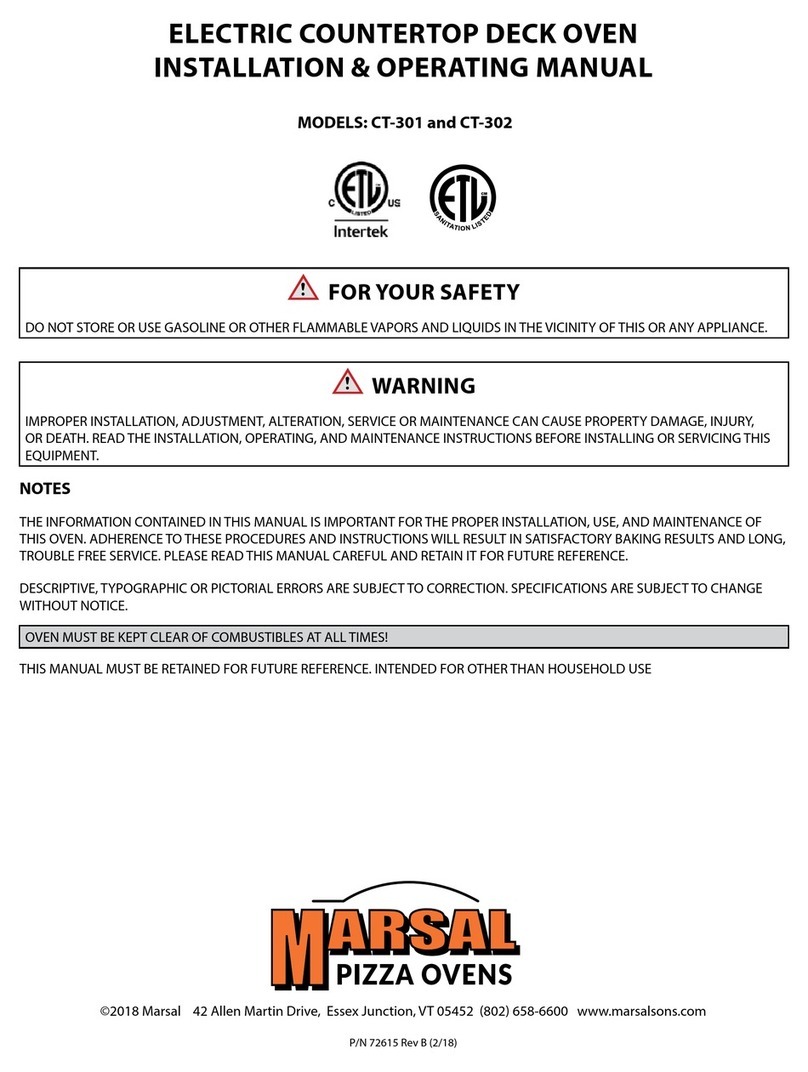
INSTALLATION & OPERATING MANUAL
Deck Ovens: MB42, MB60, MB236, MB260, SD236, SD248, SD260, SD448, SD660, SD1048, SD1060
FOR YOUR SAFETY
DO NOT STORE OR USE GASOLINE OR OTHER FLAMMABLE VAPORS AND LIQUIDS IN THE
VICINITY OF THIS OR ANY APPLIANCE.
FOR YOUR SAFETY
POST INSTRUCTIONS TO BE FOLLOWED IN THE EVENT THE USER SMELLS GAS IN A
PROMINENT LOCATION. THIS INFORMATION SHALL BE OBTAINED BY CONSULTING YOUR
LOCAL GAS SUPPLIER.
THIS MANUAL MUST BE RETAINED FOR FUTURE REFERENCE.
WARNING
ELECTRICAL GROUNDING INSTRUCTIONS
THIS APPLIANCE, WHEN INSTALLED, MUST BE ELECTRICALLY GROUNDED IN ACCORDANCE WITH LOCAL CODES,
OR IN THE ABSENCE OF LOCAL CODES, WITH THE NATIONAL ELECTRICAL CODE, ANSI/NFPA 70, OR THE CANADIAN
ELECTRICAL CODE, CSA C22.2 AS APPLICABLE.
THIS APPLIANCE IS EQUIPPED WITH A THREE PRONG (GROUNDING) PLUG FOR YOUR PROTECTION AGAINST SHOCK
HAZARD AND SHOULD BE PLUGGED DIRECTLY INTO A PROPERLY GROUNDED THREE-PRONG RECEPTACLE. DO
NOT CUT OR REMOVE THE GROUNDING PRONG FROM THIS PLUG.
KEEP THE OVEN AREA FREE AND CLEAR FROM COMBUSTIBLE AND NONCOMBUSTIBLE CONSTRUCTION. DO NOT
OBSTRUCT THE FLOW OF COMBUSTION AND VENTILATION AIR.
THIS OVEN HAS ZERO CLEARANCE ON BOTH SIDES BUT A 3” - 4” SPACE MUST BE LEFT AT THE REAR TO ALLOW
ADEQUATE CLEARANCE FOR AIR OPENINGS INTO THE COMBUSTION CHAMBER INSURING PROPER CIRCULATION
OF AIR INTO THE BURNER SYSTEM.
AN ELECTRICAL DIAGRAM IS LOCATED ON THE INSIDE OF THE CONTROL DOOR ON ALL MB SERIES OVENS.
Marsal & Sons, Inc. 175 East Homan Ave., Lindenhurst, NY 11757
IMPROPER INSTALLATION, ADJUSTMENT, ALTERATION, SERVICE OR MAINTENANCE
CAN CAUSE PROPERTY DAMAGE, INJURY, OR DEATH. READ THE INSTALLATION,
OPERATING, AND MAINTENANCE INSTRUCTIONS BEFORE INSTALLING OR SERVICING
THIS EQUIPMENT.




























